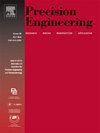Numerical and experimental study of material removal characteristics for magnetorheological micro-jet polishing
IF 3.5
2区 工程技术
Q2 ENGINEERING, MANUFACTURING
Precision Engineering-Journal of the International Societies for Precision Engineering and Nanotechnology
Pub Date : 2025-02-07
DOI:10.1016/j.precisioneng.2025.02.008
引用次数: 0
Abstract
Magnetorheological micro jet polishing (MMJP) technology has great potential for polishing components with complex surfaces, cavities, and microstructures. However, there is a lack of in-depth and systematic research on the material removal characteristics of MMJP under different processing parameters, which hinders its engineering application. This study developed a numerical model for MMJP using the Volume of Fluid (VOF) multiphase flow model and the K-W turbulence model, which was used to analyze the interaction between the flow field and the workpiece during the polishing process. To clarify the material removal process, the material removal mechanism of MMJP was investigated. The forces acting on individual abrasives in the flow field were analyzed, and a material removal model for MMJP was established based on the Preston equation. Additionally, a combined approach of simulation and experimentation was used to study the effects of different processing parameters on material removal and polishing performance. The experimental results were consistent with the numerical predictions, demonstrating the reliability of the CFD model. Finally, an orthogonal optimization experiment was designed to determine the influence hierarchy of various process factors on the polishing results. Using the optimal process parameter combination, aluminum alloy workpieces were polished, with the surface roughness reduced from 355 nm to 253 nm. This study provides theoretical support and processing guidance for the industrial application of MMJP.

求助全文
约1分钟内获得全文
求助全文
来源期刊
CiteScore
7.40
自引率
5.60%
发文量
177
审稿时长
46 days
期刊介绍:
Precision Engineering - Journal of the International Societies for Precision Engineering and Nanotechnology is devoted to the multidisciplinary study and practice of high accuracy engineering, metrology, and manufacturing. The journal takes an integrated approach to all subjects related to research, design, manufacture, performance validation, and application of high precision machines, instruments, and components, including fundamental and applied research and development in manufacturing processes, fabrication technology, and advanced measurement science. The scope includes precision-engineered systems and supporting metrology over the full range of length scales, from atom-based nanotechnology and advanced lithographic technology to large-scale systems, including optical and radio telescopes and macrometrology.

 求助内容:
求助内容: 应助结果提醒方式:
应助结果提醒方式:


